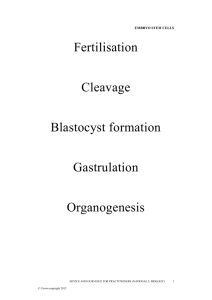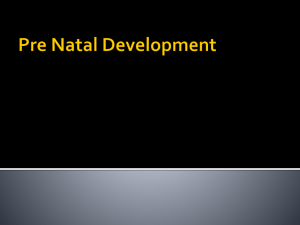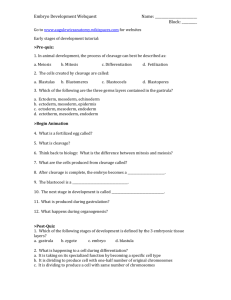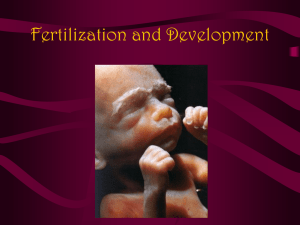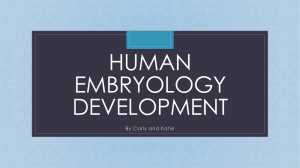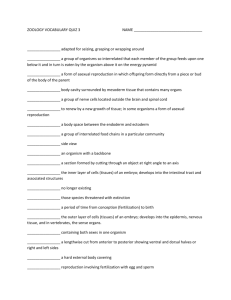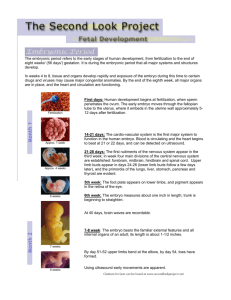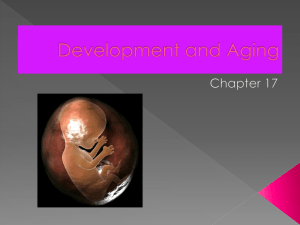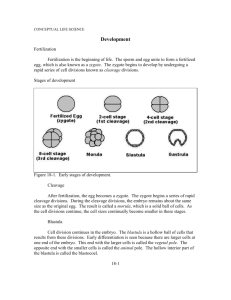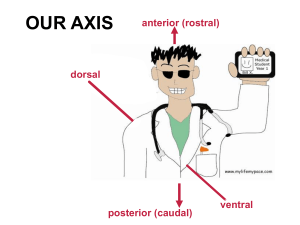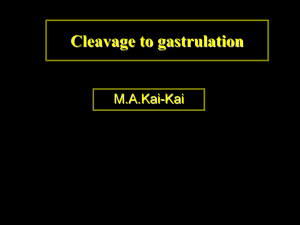gtch10ppt - JBHA-Sci-US-tri3
advertisement
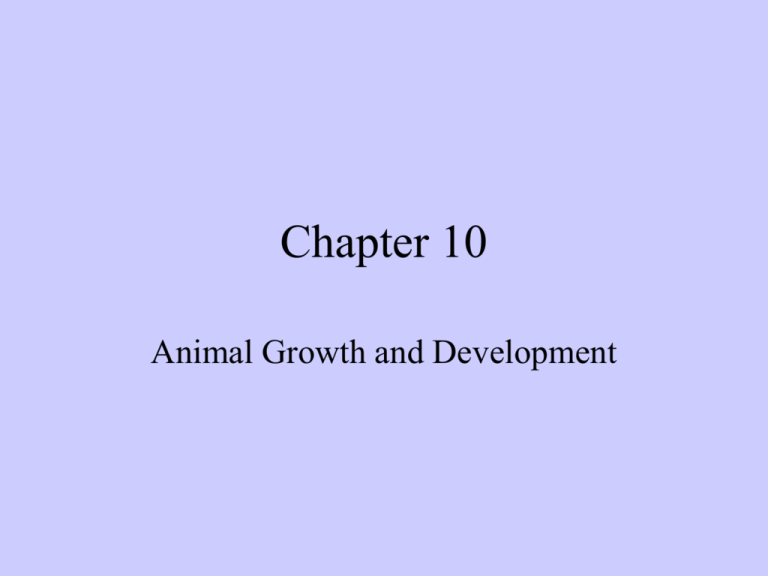
Chapter 10 Animal Growth and Development Fertilization • The beginning of new animals begins with fertilization. • Fertilization has three functions: 1.transmission of genes from both parents to offspring 2.restoration of the diploid number of chromosomes reduced during meiosis 3.initiation of development in offspring Fertilized Egg Growth, Differentiation and Form • Differentiation is the process in which cells become specialized or different from other cells. • Morphogenesis is when the specialized cells form organs and tissues. Development in Animals • Cleavage is the first step in development of ALL multi-celled organisms. Cleavage converts a single-celled zygote into a multicelled embryo by mitosis. • Frog embryos divide to produce 37,000 cells in a little over 40 hours. • By the end of cleavage the embryo consists of many cells and is called a blastula. Blastula Gastrula • As cells differentiate, they begin to migrate. • This forms three layers of cells and the embryo is now called a gastrula. • These three layers are called germ layers and will form the major structures of the body. • Gastrulation forms the ectoderm, endoderm and mesoderm. • Ectoderm forms tissues associated with outer layers: skin, hair, sweat glands, epithelium. The brain and nervous system also develop from the ectoderm. • The mesoderm forms structures associated with movement and support: body muscles, cartilage, bone, blood, and all other connective tissues. Reproductive system organs and kidneys form from mesoderm. • The endoderm forms tissues and organs associated with the digestive and respiratory systems. Many endocrine structures, such as the thyroid and parathyroid glands, are formed by the endoderm. The liver, pancreas, and gall bladder arise from endoderm. Gastrulation Pattern Formation • Blastulation and gastrulation establish the main body axis. Organ formation occurs in the next stage of the development of the embryo. During organ formation, cell division is accomplished by migration and aggregation. • Pattern formation is the result of cells "sensing" their position in the embryo relative to other cells and to form structures appropriate to that position. • Homeobox genes are pattern genes; they coordinate with gradients of information molecules to establish the body plan and development of organs. Homeobox Genes Induction • Induction is the process in which one cell or tissue type affects the developmental fate of another cell or tissue. As a cell begins to form certain structures, certain genes are turned on, others are turned off. Induction affects patterns of gene expression through physical contact or chemical signals. Formation of the vertebrate eye is a well known example. Human Development • The period of time from fertilization to birth (usually 9 months) is divided into trimesters, each about three months long. During pregnancy the zygote undergoes 40 to 44 rounds of mitosis, producing an infant containing trillions of specialized cells organized into tissues and organs. • After fertilization in the oviduct, the embryo begins to cleave as it moved down the oviduct. • After 5 days it is called a blastocyst. It looks like a blastula. • The blastocyst sinks into the uterine lining once it reaches the uterus. This is known as implantation. Useful Terms • Some of the blastocyst forms the new baby and some forms the assessory structures that provide nourishment. • The amnion is a membrane that surrounds the embryo. • The chorion is just to the outside of the amnion. • As gastrulation begins, the chorion extends villi into the lining of the uterus. The villi and uterine lining form the placenta. First Trimester • The three embryonic tissue layers form. Cellular differentiation begins to form organs during the third week. After one month the embryo is 5 mm long and composed mostly of paired somite segments. During the second month most of the major organ systems form, limb buds develop. The embryo becomes a fetus by the seventh week. Beginning the eighth week, the sexually neutral fetus activates gene pathways for sex determination, forming testes in XY fetuses and ovaries in XX fetuses. External genitalia develop. Second Trimester • The fetus increases in size during this trimester, and bony parts of the skeleton begin to form. Fetal movements can be felt by the mother. Third Trimester • During this trimester the fetus increases in size. Circulatory and respiratory systems mature in preparation for air breathing. Fetal growth during this time uses large parts of its mother's protein and calcium intake. Maternal antibodies pass to the fetus during the last month, conferring temporary immunity.
